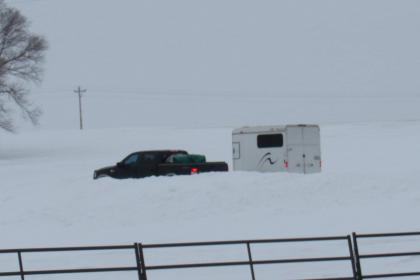After years of dreaming and sacrificing and planning, my husband and I finally bought our 26 acre hobby farm last year. It came with a fairly decent house and a pole barn attached to one of the two 2.5 acre fenced pastures (sadly, fenced with barbed wire, so we are in the process of taking the wire down and will replace with Electrobraid or similar on the existing fence posts).
Since the pole barn is attached to one of the pastures, my options are to either leave one half of the barn open as a run-in shelter and cross fence the pasture to make a dry lot next to this part of the barn, or we can build stalls inside the pole barn. We can probably fit 3 or 4 10x10 stalls easily all on one side of the barn since it’s too narrow for a center aisle configuration, with room for a feed/tack room on one end. If we go up to 12 foot stalls then probably not more than 3 stalls would fit. I currently don’t plan to have more than 3-4 horses at a time, but you know how that goes.
From an ease of caretaking standpoint, the run-in shelter idea sounds better. The horses would live out all the time, so would minimize cleaning and turnout chores. Hubby and I both work full time, so streamlining the horse care chores is probably important. We do also have two boys who can help (especially if they want to earn the money they are always asking for).
From a security and comfort standpoint, having stalls sounds like the better option, especially in our 30 below temps that we can get in the winter (oh and we’re on top of a ridge so we get brutal winds, also). Maybe I should mention that I would like to buy an OTTB or two for retraining, so that might be a factor in whether the horses can or should live out 24/7/365. I know there are lots of TBs who live outside just fine, but I know there are also hothouse flowers who have trouble keeping weight on in the best of weather, so having a snug barn to keep warm in might be better for such a horse? Then again, it will be the same barn they are standing in, whether they are in a stall or can come and go as they please if I leave it as a run-in. But if there are stalls, I can close the doors when the weather is particularly nasty.
Wish I could just go ahead and build a 10 stall barn with indoor arena, but will need to win the lottery first. Until that happens, given the two options, what would you do?


 This also means you will have to figure out what to do with the “poopsickles” that your horses will generate at the rate of 30-50 lbs/day, each.
This also means you will have to figure out what to do with the “poopsickles” that your horses will generate at the rate of 30-50 lbs/day, each.
 It’s ok. I’ve been here for 6 years now. Winters do suck. But really, it’s only January and February that are truly awful, sometimes March also. The rest of the year is tolerable to beautiful.
It’s ok. I’ve been here for 6 years now. Winters do suck. But really, it’s only January and February that are truly awful, sometimes March also. The rest of the year is tolerable to beautiful.